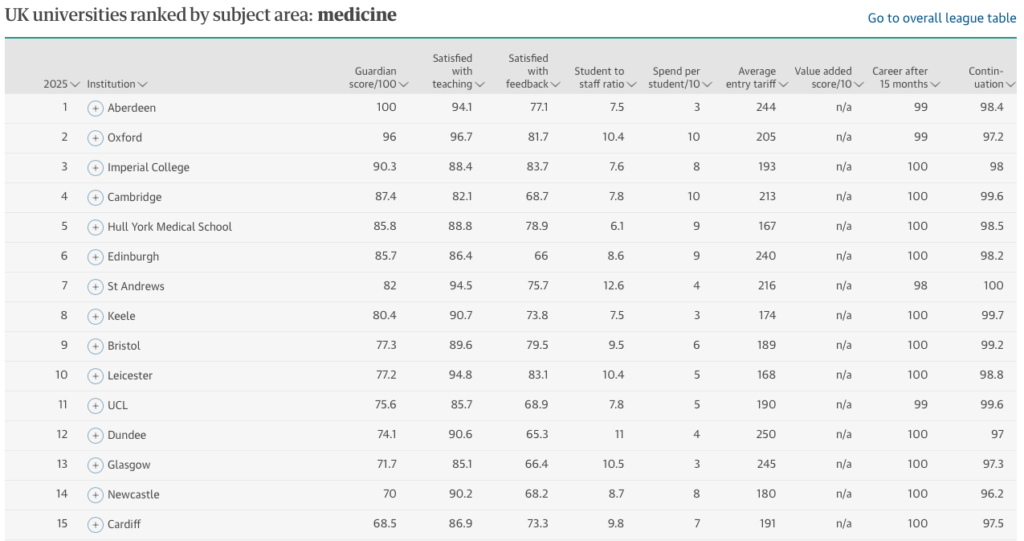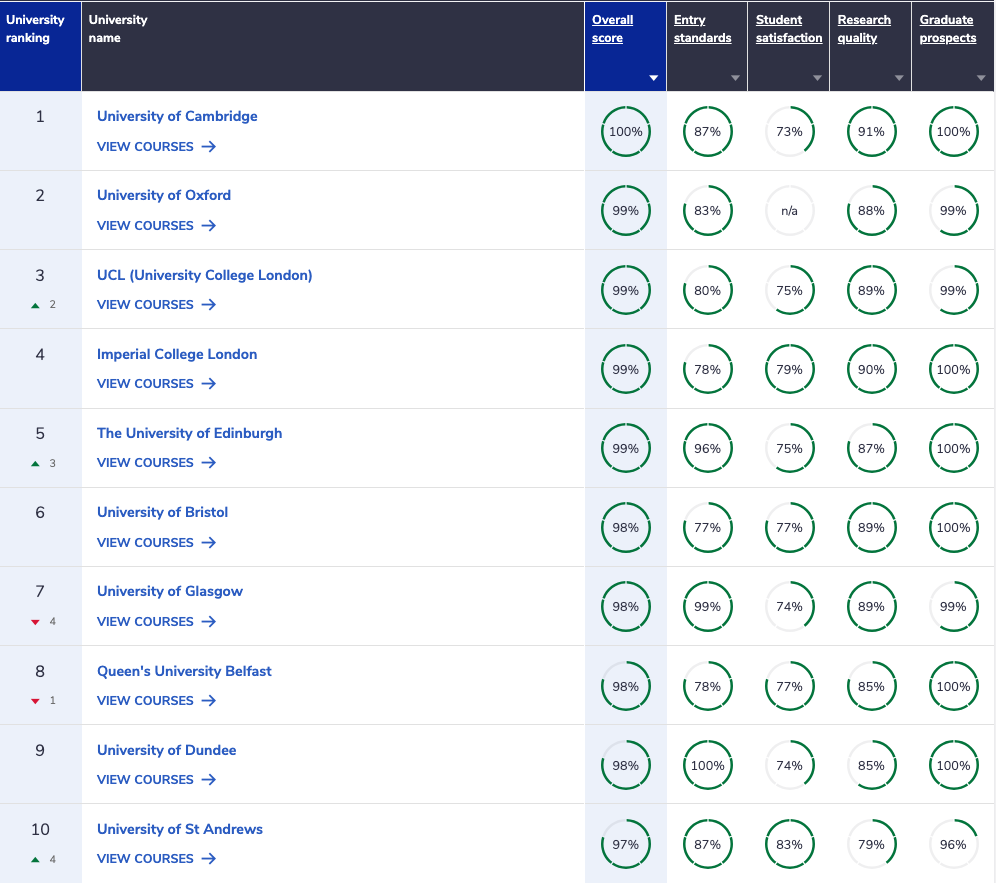UK Medical School Rankings for 2025 are now out, so which are the best medical schools in the UK?
With so many different organisations putting together lists of which Medical School is the best in the country, how do you know which ones to look at and believe? And how much importance should you actually place on medical school ranking tables?
We’ve put together this guide to explain the rankings and help you understand what to take into consideration when you’re making your choices. If you’re ready, then let’s get started!
Want to skip to the ranking tables? Press the button’s below:
Who makes the UK medical school rankings?
There are a number of different ranking guides which compile their lists using different measuring factors. The Guardian and The Complete University Guide are two of the most popular organisations that compile lists of the best universities in the UK for lots of courses, though there are also global rankings provided by different organisations like QS Top Universities.
Of course, these aren’t the only league tables around for UK Medical School rankings. A quick Google search can give you a lot more options if you’d like to compare and have multiple tables to back up your decision of which Medical School to apply to. For today though we will be focussing on just two tables.
Secure your place to study Medicine at Oxbridge with the help of UniAdmissions and our expert tutors.
We help you craft the perfect Personal Statement, achieve a highly competitive UCAT score and teach you how to Interview effectively – covering all areas of your Oxbridge Medicine application.
Discover our Full-Blue Medicine Programme by clicking the button below to enrol and triple your chances of success.
How Are UK Medical Schools Ranked?
There is no singular way to rank the UK Medical Schools. There are roughly 36 of them in total, all varying in their teaching style, selection process, and education standard.
While many different Medical School ranking tables exist, they do not all agree. This is largely because the rankings are influenced by vague or indefinable aspects, such as the reputation of the university, or the level of student satisfaction for those studying there – both are difficult to accurately measure.
That’s not to say that these ranking tables are completely unreliable, as they still help to give a general sense of how a medical school performed in a given year and how students rated their experience. It’s just important to know that a lot of the metrics covered aren’t supported by extensive data.
It’s also worth noting that even the lowest universities on these lists aren’t too low in quality. The UK is generally known for maintaining a high standard of education, including medical degrees, so the lowest-ranked universities earn their place for being less exceptional or having a couple of noticeable flaws compared to others.
Now we have a bit more context, let’s look at two of the most well-known university ranking tables, starting with The Guardian.
The Guardian Medical School Rankings
To compile their lists of Medical School rankings UK, the Guardian uses these headings to rank the schools:
- Satisfied with course (the overall rating given by final year students)
- Satisfied with teaching (quality of teaching rated by final year students)
- Satisfied with feedback (a rating for the quality of feedback and assessment by final year students)
- Student to staff ratio (the number of students per staff member)
- Spend per student (the amount of money spent on each student excluding academic staff costs)
- Value added score (a comparison of students’ degree results against the entry qualification, which shows how effectively they are taught)
- Career after 15 months (the percentage of graduates who find a job or continue further study within 15 months of graduating)
- Average entry tariff (the typical UCAS score of entrants)
- Continuation (the percentage of first year students who go on to the second year)
They then give each of these categories a score depending on the information they have collected. Finally, all Medical Schools are then given a Guardian Score out of 100, which determines the rank they receive.
Data is collected from a variety of sources, including student satisfaction results from the National Student Survey (NSS) and employability and entry standards data directly from the universities.
The Guardian Medical School Rankings 2025
Below is The Guardian’s league table in full, displaying the results for 2025 and comparison to 2024’s results:
| Position | University | Previous Position (2024) |
|---|---|---|
| 1 | University of Aberdeen | 1 (=) |
| 2 | University of Oxford | 8 (>6) |
| 3 | Imperial College London | 7 (>4) |
| 4 | University of Cambridge | 2 (<2) |
| 5 | Hull York Medical School | 15 (>10) |
| 6 | University of Edinburgh | 5 (<1) |
| 7 | University of St.Andrews | 3 (<4) |
| 8 | Keele University | 6 (<2) |
| 9 | University of Bristol | 11 (>2) |
| 10 | University of Leicester | 17 (>7) |
| 11 | University College London (UCL) | 12 (>1) |
| 12 | University of Dundee | 16 (>4) |
| 13 | University of Glasgow | 9 (<4) |
| 14 | Newcastle University | 18 (>4) |
| 15 | Cardiff University | 14 (<1) |
| 16 | Swansea University | 4 (<12) |
| 17 | University of Leeds | 21 (>4) |
| 18 | University of Sunderland | 19 (>1) |
| 19 (=) | Queen’s University Belfast | 13 (<6) |
| 19 (=) | Brighton & Sussex Medical School | 10 (<9) |
| 21 | University of Warwick | 29 (>8) |
| 22 | University of Southampton | 30 (>8) |
| 23 | University of East Anglia (UEA) | 23 (=) |
| 24 | Queen Mary University of London | 22 (<2) |
| 25 | University of Exeter | 32 (>7) |
| 26 | University of Manchester | 31 (>5) |
| 27 | University of Liverpool | 20 (<7) |
| 28 | Lancaster University | 28 (=) |
| 29 | King’s College London | 27 (<2) |
| 30 (=) | Anglia Ruskin University | (NEW) |
| 30 (=) | University of Sheffield | 25 (<5) |
| 32 | University of Birmingham | 26 (<5) |
| 33 | St George’s University of London | 35 (>3) |
| 34 | University of Plymouth | 24 (<9) |
| 35 | University of Central Lancashire | 37 (>2) |
| 36 | University of Nottingham | 34 (<2) |
| 37 | University of Buckingham | 33 (<4) |
| 38 | Aston University | 36 (<2) |
This year, The Guardian gave the top spot to the University of Aberdeen with a score of 100. This is the second year in a row that this has been the case. Closely following is the University of Oxford and tImperial College London in second and third. To only see five Russell Group universities in the Top 10 is unusual, but that’s not all:
It is also not common to see Cambridge so low on a UK ranking table, especially for a major subject. However, Cambridge hasn’t ranked 1st for Medicine on the Guardian’s table since 2019 and had previously ranked as low as 6th. In 2024, Oxford ranked even lower than this, finishing in 8th.
Aston University, located in Birmingham, took the last position in 2025 for the second year in a row with a score of 33.1. However, the following medical schools were not featured in this year’s ranking:
- Brunel University London
- Edge Hill University
- Ulster University
Compared to last year’s results, we can see the most dramatic change was for Swansea University, which fell twelve spots from 4th to 18th. The biggest improvement was for Hull York Medical School, which rose ten spots from 15th to 5th. Anglia Ruskin University did not appear on 2024’s list but was ranked joint 30th in 2025.
Access "The Oxbridge Application Vault"
- 300+ page ebook for Oxbridge Applicants
- 25 page ebook for Personal Statement
- 2h+ online course to succeed in any exam
- Online Oxbridge Success Calculator
- 12 page ebook about UniAdmissions

Access "The Big Book Of Oxbridge Applications" For FREE
Considering studying Medicine at Cambridge or Oxford? Download The Big Book Of Oxbridge Applications for free here to discover everything you need to know about Oxbridge Medicine and its application process. Through over 350 pages, you’ll find:
- Over 40 admissions test practice questions
- 28 example Oxbridge Personal Statements
- Interviews with Oxbridge students and graduates
- Additional downloadable resources
Fill in your details below to claim your digital copy today!

The Complete University Guide Medical School Rankings
The second and equally respected university league table is produced by The Complete University Guide. Their Medical School rankings are based on a slightly different set of criteria, although there is a lot of overlap.
To compile their lists of UK Medical School rankings, these are the headings to rank the schools:
- Entry Standards (the average UCAS tariff of students joining the university)
- Student Satisfaction (how satisfied students are with the quality of teaching they receive)
- Research Quality (a measure of the quality of research undertaken in the university)
- Graduate Prospects (a measure of the employability of beyond graduation)
- Overall Score (an overall score that determines the rank of the medical school)
There are also a few other factors taken into consideration that have an impact on the overall score awarded to medical Schools. These aren’t displayed on the main ranking table but are as follows:
- Research intensity (the proportion of staff involved in research)
- Student:staff ratio (the number of students to staff)
- Academic services spend (the spend per student on all academic services)
- Facilities spend (the spend per student on staff and student facilities)
- Good honours (the number of students achieving first or 2:1 degrees)
As with The Guardian, each category has a weighting attached to it, which then feeds into the final “Overall Score” achieved by a university. This overall score is what determines the Medical School’s rank in the UK. Like The Guardian, much of this data is collected from the NSS and the universities.

Find out your percentage chance of getting into Oxford or Cambridge and get a complete report upon completion talking through your strengths and weaknesses.
Complete University Guide Medical School Ranking Table 2025
Below is the full Complete University Guide ranking table, displaying the results for 2025 and comparison to 2024’s results:
| Position | University | Previous Position (2023) |
|---|---|---|
| 1 | University of Cambridge | 1st (=) |
| 2 | University of Oxford | 2nd (=) |
| 3 | University College London (UCL) | 5th (>2) |
| 4 | Imperial College London | 4th (=) |
| 5 | University of Edinburgh | 8th (>3) |
| 6 | University of Bristol | 6th (=) |
| 7 | University of Glasgow | 3rd (<4) |
| 8 | Queen’s University Belfast | 7th (<1) |
| 9 | University of Dundee | 9th (=) |
| 10 | University of St.Andrews | 14th (>4) |
| 11 | University of Leicester | 11th (<1) |
| 12 | Queen Mary University of London | 16th (>4) |
| 13 | Swansea University | NEW |
| 14 | Cardiff University | 11th (<3) |
| 15 | King’s College London | 12th (<3) |
| 16 | Lancaster University | 13th (<3) |
| 17 | University of Sheffield | 15th (<2) |
| 18 | Keele University | 17th (<1) |
| 19 | University of Aberdeen | 18th (<1) |
| 20 | University of Manchester | 20th (=) |
| 21 | Hull York Medical School | 21st (=) |
| 22 | Newcastle University | 23rd (>1) |
| 23 | University of Exeter | 22nd (<1) |
| 24 | University of Birmingham | 19th (<5) |
| 25 | University of Leeds | 25th (=) |
| 26 | University of East Anglia (UEA) | 24th (<2) |
| 27 | Brighton & Sussex Medical School | 26th (<1) |
| 28 | St.George’s University of London | 28th (=) |
| 29 | University of Plymouth | 31st (>2) |
| 30 | University of Southampton | 30th (=) |
| 31 | University of Liverpool | 27th (<4) |
| 32 | University of Nottingham | 29th (<3) |
| 33 | University of Warwick | NEW |
| 34 | Anglia Ruskin University | NEW |
| 35 | University of Buckingham | 32nd (<3) |
| 36 | University of Central Lancashire | 33rd (<3) |
In The Complete University Guide’s ranking, Cambridge takes the top spot again. Oxford, UCL and Imperial each follow with very high scores but Cambridge just edges them out with a 100% score. Be aware that Complete University Guide refers to this table as their 2025 ranking in reference to the year of entry that this year’s applicants will be applying for.
As you can see, there’s very little consistency between the top 5 in each table, with only two universities appearing in both and only one university sitting in the same spot on each (Edinburgh at 5th).
The University of Central Lancashire once again takes the last position with a score of 89%, which still seems very high! However, this is a conclusion that both tables seem to agree on. The following medical schools did not feature on this ranking:
- Aston University
- Brunel University London
- Edge Hill University
- University of Sunderland
- Ulster University
Compared to The Guardian’s ranking, far more universities maintained their space this year, including three of the top five. The biggest position change came from the University of Birmingham, which fell five slots from 19th to 24th.
By considering just these two ranking tables of Medical Schools in the UK, we can see that there isn’t a “confirmed” ranking list that everyone can agree on. This split is confirmed further when looking at other ranking providers like Time Higher Education, so the conclusions made in these tables should not be the only influence in your decision-making process.
Access "The Big Book Of Oxbridge Applications" For FREE
Considering studying medicine at Oxford or Cambridge? Download The Big Book Of Oxbridge Applications, for free here to discover everything you need to know about Oxbridge Medicine and its application process. Through over 350 pages, you’ll find:
- Over 40 admissions test practice questions
- 28 example Oxbridge Personal Statements
- Interviews with Oxbridge students and graduates
- Additional downloadable resources
Fill in your details below to claim your digital copy today!

The Best and Worst UK Medical Schools
It needs to be made clear again that these rankings are not definitive in any sense, nor is there a way to calculate the definitive “best” medical school in the UK. While factors such as employment rates and student satisfaction can be measured to a certain degree, each person will have their own preferences as to how they want to study and live at university.
With that being said though, let’s round up the data and see which medical schools ranked highest and lowest between the two tables:
Best Universities For Medicine UK
The highest-ranked medical schools in the UK tend to stay consistent from year to year, although their placements may move around. In 2025, the University of Cambridge and University of Aberdeen took the top spots, with both receiving perfect 100 scores. Of course, the overall score doesn’t mean these universities are literally perfect, but they are consistently high-scoring in many of the metrics that are recorded.
Let’s look at the top five UK medical schools for each list:
Complete University Guide
- University of Cambridge
- University of Oxford
- University College London (UCL)
- Imperial College London
- University of Edinburgh
The Guardian
- University of Aberdeen
- University of Oxford
- Imperial College London
- University of Cambridge
- Hull York Medical School
From these lists, we can see that there is a fair amount of disparity between the two rankings, with only three shared entries between the two. These are three of the most commonly high-ranked universities in the UK, so this isn’t surprising, but the other entries are interesting.
Of these, The Guardian ranked UCL and Edinburgh in 11th and 6th respectively. Meanwhile, Complete University Guide ranked Aberdeen and Hull York in 19th and 21st, showing a major difference in how the two tables are calculated.
Two London universities appear in the Complete University Guide’s top 5, while only one appears in The Guardian’s. The highest-ranked London medical school on that list was Imperial College London in 3rd.

Worst Medical Schools UK
Any ranking must have a bottom rank, but in this case, the bottom ranking shouldn’t be taken as a list of medical schools to avoid. Worst is a very strong word to use in this context as none of the universities listed here are bad. They simply placed at the bottom of a highly competitive ranking.
Nonetheless, here are the lowest-ranked medical schools in the UK in ascending order:
Complete University Guide
- University of Central Lancashire
- University of Buckingham
- Anglia Ruskin University
- University of Warwick
- University of Nottingham
The Guardian
- Aston University
- University of Buckingham
- University of Central Lancashire
- University of Nottingham
- University of Plymouth
UCLAN and Aston take the bottom spots on the two tables, with only two shared entries between them. It’s worth noting that, especially with the Complete University Guide’s scoring system, none of these universities score particularly poorly. While they may not be exceptional in many areas, the education provided at these medical schools is of a high standard and will give you the best chance of employment afterwards. As we said before, these medical schools aren’t bad; they just had some truly exceptional competition.
We know the rankings featured in each table individually, but how do the results looked when considering both tables?
Below, we have created a table that combines the ranking positions for each university from both tables to determine the order based on both opinions. When looking at the combined positions, a lower total equals a higher ranking For example, Cambridge ranked 1st & 2nd in the two tables, so it received a combined ranking of 3, making it the highest-ranked medical school in the UK. Let’s take a look:
UniAdmissions' Combined Medical School Rankings
| Position | University | Combined Ranking Score |
|---|---|---|
| 1 | University of Oxford | 4 |
| 2 | University of Cambridge | 5 |
| 3 | Imperial College London | 7 |
| 4 | University of Edinburgh | 11 |
| 5 | University College London (UCL) | 14 |
| 6 | University of Bristol | 15 |
| 7 | University of St.Andrews | 17 |
| 8 | University of Aberdeen | 20 |
| 8 | University of Glasgow | 20 |
| 9 | University of Dundee | 21 |
| 9 | University of Leicester | 21 |
| 10 | Hull York Medical School | 26 |
| 10 | Keele University | 26 |
| 11 | Queen’s University Belfast | 27 |
| 12 | Cardiff University | 29 |
| 12 | Swansea University | 29 |
| 13 | Newcastle University | 36 |
| 13 | Queen Mary University of London | 36 |
| 14 | University of Leeds | 42 |
| 15 | King’s College London | 44 |
| 15 | Lancaster University | 44 |
| 16 | Brighton & Sussex Medical School | 46 |
| 16 | University of Manchester | 46 |
| 17 | University of Sheffield | 47 |
| 18 | University of Exeter | 48 |
| 19 | University of East Anglia (UEA) | 49 |
| 20 | University of Southampton | 52 |
| 21 | University of Warwick | 54 |
| 22 | University of Birmingham | 56 |
| 23 | University of Liverpool | 58 |
| 24 | St George’s University of London | 61 |
| 25 | University of Plymouth | 63 |
| 26 | Anglia Ruskin University | 64 |
| 27 | University of Nottingham | 68 |
| 28 | University of Central Lancashire | 71 |
| 29 | University of Buckingham | 72 |
| NA | University of Sunderland | 19 (Not featured on Complete Uni Guide) |
| NA | Aston University | 36 (Not featured on Complete Uni Guide) |
From this table, we can see that Oxford was the highest-ranked medical school overall in the UK, despite not ranking first on either table. Oxford and Cambridge, which came in second, rank high in terms of quality, but the acceptance rates at each university are very low compared to many others. Learn more about this in our Cambridge Acceptance Rates Guide and Oxford Acceptance Rates Guide.
The University of Buckingham ranks at the bottom of our list with a total score of 72, although two universities did not qualify as they did not appear on both ranking tables.
While this list isn’t a more accurate measurement of which medical schools are best, it does help to make the comparison between the two tables a bit easier.
Which Ranking Table Should I Follow?
That depends on what’s most important to you. For example, you may place more importance on ‘spend per student’ or career prospects. The Guardian have created their own way of ranking universities which is largely based on student perspective and The Complete University Guide, on the other hand, puts focus on student satisfaction.
You also need to consider that the ranking of the university as a whole is also based on the quality of research being produced by the postgraduate Masters and PhD students, which has little to do with the experience of a Medical undergraduate.
It can be easy to get very carried away with all these different ratings and rankings of the best Medical Schools in the UK. While it is true that these subtle differences may affect your experience at university, you should keep in mind that all of these Medical Schools are highly rated universities with excellent rankings across the board.
However, it is crucial to remember that no matter which Medical School you attend, you will graduate with the future of a fully respected career which is boundless in its opportunities. So don’t get too worried if you don’t end up being able to go to the medical schools at the very top of the list.
Ultimately, it’s a matter of what you are looking for in a University when it comes to how you choose which Medical School you want to apply to.
Oxbridge Medicine is incredibly competitive and it helps to have an edge. Our expert support will help you receive your dream offer.
With unlimited hours of guided study (including One-To-One Tuition, Mock Interviews, Intensive Courses and Comprehensive Materials), our expert Full-Blue Medicine Programme truly gives you an advantage that can make the difference between an offer and rejection.
Discover our Full-Blue Medicine Programme by clicking the button below to enrol and triple your chances of success.










